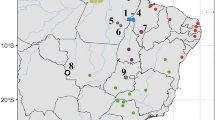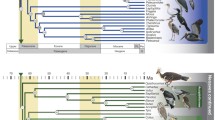Abstract
We report three sets of DNA hybridization experiments conducted to determine relationships among species ofDidelphis (D. albiventris, D. marsupialis, D. virginiana). The 1989 and 1991 sets had fewer replicates per cell than the 1990 series (3.4 and 5.4 vs 9), but in 1991 we distinguished two populations ofD. marsupialis and utilized several individuals for each heterologous comparison. BothPhilander opossum andLutreolina crassicaudata were used as outgroups in 1989, but onlyLutreolina was included in subsequent sets. For each set, we calculated all four standard indices of thermal stability (T mode,T m,T 50 H, and NPH) and constructed trees by least-squares (FITCH) and neighbor-joining methods, both before and after correction for asymmetric reciprocal cell values. Subsets of the 1989 data lacking eitherPhilander orLutreolina were analyzed similarly. To explore measurement imprecision, the corrected and uncorrected matrices for each of the four indices were bootstrapped 100 times for the 1989 set and subsets and 1000 times for the 1990 and 1991 sets. Again, for the 1990 and 1991 data, an additional 100 bootstrapped distances were fitted to user trees representing the three possible pairings ofDidelphis spp. to determine the significance of the FITCH branch lengths. The successive experimental sets generated increasingly consistent evidence for pairingD. marsupialis withD. albiventris. The 1989 experiments involved just 85 comparisons, and only ΔT mode's pairedD. marsupialis withD. albiventris (at bootstrap percentages of 70% or above), but did so whetherPhilander orLutreolina or both were included as the outgroup(s). FITCH and neighbor-joining trees had identical topologies for ΔT mode's but sometimes differed for the other measures. In contrast, all but one of the corresponding FITCH and neighborjoining trees matched for the 1990 and 1991 data, and three of the four distance measures (ΔT mode, ΔT m, and ΔT 50 H) unitedD. marsupialis withD. albiventris at bootstrap percentages averaging 81%; ΔNPH gave a different result for 1990, associatingD. marsupialis withD. virginiana. Further, all but 2 of the 16 matrices for 1990 and 1991 gave mean bootstrapped branch lengths for a consensus pairing that were positive and at least one standard deviation from zero, despite the very short internodes recovered. These results illustrate that the potential of DNA hybridization for resolving very close relationships depends on both the index and the experimental design employed. We conclude that of the three species,D. albiventris andD. marsupialis shared a more recent common ancestor and estimate thatDidelphis spp. have diverged at about 0.39% in nucleotide sequence per myr.
Similar content being viewed by others
Literature cited
Allen, J. A. (1901). A preliminary study of the North American opossums of the genusDidelphis.Bull. Am. Mus. Nat. Hist. 14 149–195.
Allen, J. A. (1902). A preliminary study of the South American opossums of the genusDidelphis.Bull. Am. Mus. Nat. Hist. 16 249–279.
Bleiweiss, R., and Kirsch, J. A. W. (1993a). Experimental analysis of variance for DNA hybridization I: Accuracy.J. Mol. Evol. (in press).
Bleiweiss, R., and Kirsch, J. A. W. (1993b). Experimental analysis of variance for DNA hybridization II: Precision.J. Mol. Evol. (in press).
Catzeflis, F. M. (1990). DNA hybridization as a guide to phylogenies: Raw data in muroid rodents. InEvolution of Subterranean Mammals at the Organismal and Molecular Levels, E. Nevo and O. A. Reig, eds., pp. 317–345, Wiley-Liss, New York.
Catzeflis, F. M., Sheldon, F. H., Ahlquist, J. E., and Sibley, C. G. (1987). DNA-DNA hybridization evidence of the rapid rate of muroid rodent DNA evolution.Mol. Biol. Evol. 4 242–253.
Catzeflis, F. M., Dickerman, A. W., Michaux, J., and Kirsch, J. A. W. (1993). DNA hybridization and rodent phylogeny. InMammal Phylogeny: Placentals, F. S. Szalay, M. J. Novacek, and M. C. McKenna, eds., pp. 159–172, Springer-Verlag, New York.
Dickerman, A. W. (1991). Among-run artifacts in DNA hybridization.Syst. Zool. 40 494–499.
Felsenstein, J. (1984). Distance methods for inferring phylogenies: A justification.Evolution 38 16–24.
Felsenstein, J. (1985). Confidence limits on phylogenies: An approach using the bootstrap.Evolution 26 123–131.
Felsenstein, J. (1987). Estimation of hominoid phylogeny from a DNA hybridization data set.J. Mol. Evol. 26 123–131.
Felsenstein, J. (1990).PHYLIP, Phylogenetic Inference Package, Program and Documentation, Version 3.3, University of Washington, Seattle.
Gardner, A. L. (1973). The systematics of the genusDidelphis (Marsupialia: Didelphidae) in North and Middle America.Spec. Publ. Mus. Tex. Tech Univ. 4 1–81.
Hall, E. R., and Kelson, K. R. (1959).The Mammals of North America, Ronald Press, New York.
Hershkovitz, P. (1951). Mammals from British Honduras, Mexico, Jamaica and Haiti.Fieldiana Zool. 31 547–570.
Hershkovitz, P. (1969). The evolution of mammals on southern continents. VI. The Recent mammals of the Neotropical Region: A zoogeographic and ecological review.Q. Rev. Biol. 44 1–70.
Jukes, T. H., and Cantor, C. R. (1969). Evolution of protein molecules. InMammalian Protein Metabolism, H. N. Munro, ed., pp. 21–123, Academic Press, New York.
Kirsch, J. A. W., Ganje, R. J., Olesen, K. G., Hoffman, D. W., and Bledsoe, A. H. (1990a). TED, an improved thermal elution device for the simultaneous hydroxyapatite chromatography of solution DNA/DNA hybrids.BioTechniques 8 504–506.
Kirsch, J. A. W., Krajewski, C., Springer, M. S., and Archer, M. (1990b). DNA-DNA hybridization studies of carnivorous marsupials. II. Relationships among dasyurids (Marsupialia: Dasyuridae).Aust. J. Zool. 38 673–696.
Kirsch, J. A. W., Springer, M. S., Krajewski, C., Archer, M., Aplin, K., and Dickerman, A. W. (1990c). DNA/DNA hybridization studies of carnivorous marsupials. I. The intergeneric relationships of bandicoots (Marsupialia: Perameloidea).J. Mol. Evol. 30 434–448.
Kirsch, J. A. W., Dickerman, A. W., Reig, O. A., and Springer, M. S. (1991). DNA hybridization evidence for the Australasian affinity of the American marsupialDromiciops australis.Proc. Natl. Acad. Sci. USA 88 10465–10469.
Krajewski, C. (1989). Phylogenetic relationships among cranes (Gruiformes: Gruidae) based on DNA hybridization.Auk 106 603–615.
Krajewski, C., and Dickerman, A. W. (1990). Bootstrap analysis of phylogenetic trees derived from DNA hybridization distances.Syst. Zool. 39 383–390.
Marks, J., Schmid, C. W., and Sarich, V. M. (1988). DNA hybridization as a guide to phylogeny: Relations of the Hominoidea.J. Hum. Evol. 17 769–786.
Marshall, C. R. (1991). Statistical tests and bootstrapping: Assessing the reliability of phylogenies based on distance data.Mol. Biol. Evol. 8 386–391.
Marshall, L. G. (1987). Systematics of Itaboraian (Middle Paleocene) age “opossum-like” marsupials from the limestone quarry at São José de Itaborai, Brazil. InPossums and Opossums Studies in Evolution, M. Archer, ed., pp. 91–160, Surrey Beatty & Sons, Chipping Norton.
Mondolfi, E., and Pérez-Hernádez, R. (1984). Una nueva subespecie de zarigüeya del groupoDidelphis albiventris (Mammalia-Marsupialia).Acta Cientif. Venezol. 35 407–413.
Pine, R. H. (1973). Anatomical and nomenclatural notes on opossums.Proc. Biol. Soc. Wash. 86 391–402.
Reig, O. A., Gardner, A. L., Bianchi, N. O., and Patton, J. L. (1977). The chromosomes of the Didelphidae (Marsupialia) and their evolutionary significance.Biol. J. Linn. Soc. Lond. 9 191–216.
Reig, O. A., Kirsch, J. A. W., and Marshall, L. G. (1987). Systematic relationships of the living and Neocenozoic American “opossum-like” marsupials (Suborder Didelphimorphia), with comments on the classification of these and of the Cretaceous and Paleogene New World and European metatherians. InPossums and Opossums Studies in Evolution, M. Archer, ed., pp. 1–89, Surrey Beatty & Sons, Chipping Norton.
Rohlf, F. J. (1990).NTSYS-pc Numerical Taxonomy and Multivariate Analysis System, Program and Documentation, Version 1.60, Exeter Software, Setauket.
Saitou, N., and Nei, M. (1987). The neighbor-joining method: A new method for reconstructing phylogenetic trees.Mol. Biol. Evol. 4 406–425.
Sarich, V. M., and Cronin, J. E. (1976). Molecular systematics of the primates. InMolecular Anthropology, M. Goodman and R. E. Tashian, eds., pp. 141–170, Plenum Press, New York.
Sarich, V. M., Schmid, C. W., and Marks, J. (1989). DNA hybridization as a guide to phylogenies: A critical analysis.Cladistics 5 3–32.
Sheldon, F. H. (1987). Phylogeny of herons estimated from DNA-DNA hybridization data.Auk 104 97–108.
Sheldon, F. H., and Bledsoe, A. H. (1989). Indexes to the reassociation and stability of solution DNA hybrids.J. Mol. Evol. 29 328–343.
Sibley, C. G., and Ahlquist, J. E. (1984). The phylogeny of the hominoid primates as indicated by DNA-DNA hybridization.J. Mol. Evol. 20 2–15.
Sibley, C. G., and Ahlquist, J. E. (1987). DNA hybridization evidence of hominoid phylogeny: Results from an expanded data set.J. Mol. Evol. 26 99–121.
Sibley, C. G., and Ahlquist, J. E. (1990).Phylogeny and Classification of Birds: A Study in Molecular Evolution, Yale University Press, New Haven, CT.
Sibley, C. G., Comstock, J. A., and Ahlquist, J. E. (1990). DNA hybridization evidence of hominoid phylogeny: A reanalysis of the data.J. Mol. Evol. 30 202–236.
Simpson, G. G. (1972). Didelphidae from the Chapadmalal Formation in the Museo Municipal de Ciencias Naturales of Mar del Plata.Mar Plata Mus. Cienc. Nat. Publ. 2 1–40.
Simpson, G. G. (1974). Notes on Didelphidae (Mammalia, Marsupialia) from the Huayquerian (Pliocene) of Argentina.Am. Mus. Novit. 2259 1–15.
Springer, M. S. (1988).The Phylogeny of Diprotodontian Marsupials Based on Single-Copy DNA-DNA Hybridization and Craniodental Anatomy, Ph.D. dissertation, University of California, Riverside.
Springer, M. S., and Kirsch, J. A. W. (1991). DNA hybridization, the compression effect, and the radiation of diprotodontian marsupials.Syst. Zool. 40 131–151.
Templeton, A. R. (1985). The phylogeny of the hominoid primates: A statistical analysis of the DNA-DNA hybridization data.Mol. Biol. Evol. 2 420–433.
Werman, S. D., Springer, M. S., and Britten, R. J. (1990). Nucleic acids I: DNA-DNA hybridization. InMolecular Systematics, D. M. Hillis and C. Moritz, eds., pp. 204–249, Sinauer Associates, Sunderland, MA.
Author information
Authors and Affiliations
Additional information
Deceased.
Rights and permissions
About this article
Cite this article
Kirsch, J.A.W., Bleiweiss, R.E., Dickerman, A.W. et al. DNA/DNA hybridization studies of carnivorous marsupials. III. Relationships among species ofDidelphis (Didelphidae). J Mammal Evol 1, 75–97 (1993). https://doi.org/10.1007/BF01027600
Issue Date:
DOI: https://doi.org/10.1007/BF01027600




